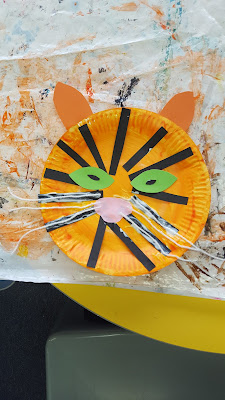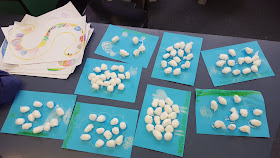Which is why a few people, including myself, are slightly amused to see me as a New Entrant teacher this term.
I decided to go for this role as I really liked the school, the staff and the students, and I thought it was high time I stretched myself professionally and got outside of my comfort zone and learnt how this New Entrant teaching thing was done. Mixed into that, I wanted to explore play based learning as a philosophy.
And boy, am I learning a lot!!
I am the first port of call in teaching these things:
- sitting on the mat
- not disappearing out the door
- coming into class when the bell goes
- taking turns
- listening and following instructions
- how to stick things down
- how to use a paint brush without going through the paper
- colouring in between the lines
- how to cut stuff out
Apart from those old standards of "Walk, don't run" or "Keep your hands to yourself", I've added such stunning phrases to my standard fare as "We don't put the toys/pens/pencils in our mouths" and "Your feet do not go in your lunchbox". I think I talk too much because I am losing my voice every day. For my personal health and safety, I will need to find a way to modify my practice to save my voice.
I'm also having a fast learning curve on Autism too. I've had students with Autism before, but every child is unique and has their own peculiarities, talents, challenges and delights.
I have a wee girl with Autism and sometimes she is willing to do what we are doing and other times I have to try my best to coax her and find ways and means of her wanting to be included. She gets high anxiety. Today it was over a spider being in the girls toilets; the other day it was because a certain person looked at her. Dad and I had a meeting the other week where I let him know the issues happening and got some feedback from him on how they manage the anxiety and other issues at home.
Sometimes I can de-escalate the anxiety; many other times I fail. And now she has a taste for fleeing the class when she does not want to do something. I do not have a teacher aide in the room for her (still doing the paperwork for ORS), so occasionally, when the admin team do not answer their phones, I've had to leave my class on their own to stop her from disappearing down the road.
So I need to find another way of keeping her inside that doesn't include having to have the doors constantly shut. Fencing for the New Entrant/Year One classes won't be done until next year to accommodate another student on ORS funding, who is also a flight risk.
I'm thinking of introducing a safe cave for her as she is light sensitive. But the challenge is in making it a space for her and not having every other child invade it. I'm also thinking of creating a form of recognition for her participating in whole class activities and staying in class. I've set up a similar one for two other students who sometimes struggle to show respect and participate appropriately.
Each row represents first, middle and third blocks of learning. The first box in each block is mat time. The second box covers any activities we do and Play Exploration time. The third box covers packing up time. If I get no issues, the child gets a star for their box. The child gets a verbal warning if an undesirable behaviour happens. If the behaviour is repeated, the child receives a dot under the box. If no further warnings happen, they get half a star for that time. If they get a second dot, there is no star for that time. If they get four dots they go to time out in another room. I photograph this each day as a record. One child's parent is emailed the photo each day as she wants to monitor in-school behaviour to ensure learning progress can happen.
So I am thinking of adapting this to my wee girl. A box for mat time, a box for doing the activity, a box for tidying up (she hates that time the most), and a fourth box for staying in the classroom. Now to put it into action!
The ORS student is in my room too. I've had an ORS student previously, but again, each one is an individual and has their own challenges and delights. This student is non-verbal and it is a challenge to find a way to include him into class activities as he is functioning at such a low level intellectually.
I want to explore how we can provide the best learning for this boy as he will never be in a position to participate at any level in a mainstream programme, I feel that I am not quite equipped to provide what he needs, and neither is the school (despite doing its very best to provide spaces and personnel and support to all involved) even with a special school teacher onsite three mornings a week. So I want to explore what other options are available to him to grow the potential he possibly has while allowing him to attend a mainstream school as his family wish for him. So I'd really value any suggestions in the comments.
Over the last few weeks, I've had my CRT days. This has been really valuable for me. I've learned about the testing at this level that I've never had to do with older children. JAM, for example, is new to me, as is how to administer and assess Marie Clay's Letter Identification and Dictation tasks.
But it has also given me the chance to spend time one-on-one with each child and talk to them and learn where they are at, what they know, what their gaps are. This is great because it then means I have to up my game and change how I do things, tweak stuff, to ensure they are clicking with the alphabet and numbers and sight words and so on. So I've spent a bit of time talking to the teacher in the next room and my cousin, the RTLit, on how I can do things a wee bit better.
Every day is a learning curve. What happened well yesterday or this morning may not work during the next block. The children reacted poorly to hot weather last week and were like wilting plants in the afternoon blocks with barely the energy to sit. This has been another added challenge and something to consider when planning the day.
I am sure that the next two weeks and four days will bring further lessons for me as the teacher.



















































